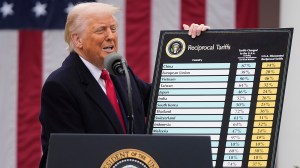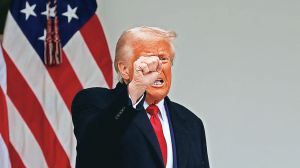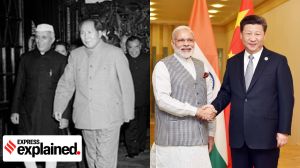Where does Trump’s retaliatory tariff move leave Apple’s ‘make in India’ story?
India, where the company has shifted 10-15 per cent of its iPhone production and has become a base for exports for the company, is receiving a 26 per cent tariff as part of Trump’s latest move.
 After years of insulating itself from any major trade-related disruptions, Apple is now finding itself in the crosshairs of the new world order that Trump is setting up. (Photo/Reuters & Express File)
After years of insulating itself from any major trade-related disruptions, Apple is now finding itself in the crosshairs of the new world order that Trump is setting up. (Photo/Reuters & Express File)Apple’s stock was down more than 7 per cent in after hours trading after US President Donald Trump announced retaliatory tariffs on a slew of countries, including some that are crucial production hubs for the company: China, India and Vietnam. After years of insulating itself from any major trade-related disruptions, the iPhone maker is now finding itself in the crosshairs of the new world order that Trump is setting up.
India, where the company has shifted 10-15 per cent of its iPhone production and has become a base for exports for the company, is receiving a 27 per cent tariff as part of Trump’s latest move. The company assembles iPhones in the country through its contract manufacturers Foxconn and Tata Electronics, and is the prime beneficiary of New Delhi’s production linked incentive (PLI) scheme for smartphones. The company is understood to also have increased its supplier base in India to 64, compared to the 14 suppliers it had here earlier, underscoring its gradual move towards assembling in India.
The reciprocal tariff on China, where Apple still has the most substantial manufacturing presence, is 34 per cent, plus the existing 20 per cent rate which Trump had imposed on the country in early days of his administration, bringing the total rate to 54 per cent. Vietnam, where the company makes some AirPods, iPads, Apple Watches and Macs, will be hit with a 46 per cent levy.
These tariffs mean that it will become more expensive for Apple, than it currently is, to export its produced goods from these countries to the US — meaning that the company could either reduce production there, or pass on the additional cost to consumers, which would make its products pricier.
“There is going to be some short-term discomfort, but the trade agreement with the US could ease some of that. As far as Apple is concerned, the silver lining is that of its major production bases — China, India and Vietnam — India has received the lowest tariff rate. But we have to see how the situation evolves,” a senior government official said, as New Delhi assesses the impact of Trump’s tariff action.
“The 26 per cent tariffs imposed by the US present a significant challenge to India’s exports, given that the US is India’s largest trading partner, accounting for 18 per cent of total goods exports. The speed and scale of these tariff hikes could further slow global growth, create market uncertainty, and pressure businesses worldwide. While India is better positioned than many other economies, these tariffs can potentially impact domestic industries, disrupt trade flows, and squeeze profit margins,” said Ashok Chandak, president of the Indian Electronics and Semiconductor Association (IESA).
Incidentally, as per Trump’s original announcement, India’s reciprocal tariff levy was 26 per cent. However, the annexure to the executive order issued subsequently by the White House mentioned a 27 per cent adjusted reciprocal tariff for India
Apple did not respond to an immediate request for comment.
“Tariffs may impact India’s booming exports, but India could remain competitive as China, Vietnam, Taiwan and Thailand face even higher tariffs. India’s low electronics imports from the US provide room for tariff adjustments to maintain trade balance,” Chandak added.
Since Trump assumed office earlier this year, he signalled that he intended to bring back manufacturing to the US, which the country has lost out on to some of its Asian peers like China and Taiwan. Apple, whose supply chains are tightly tied to China, has had to walk a geopolitical tightrope, even as the company moves to diversify from the country. Apple has announced a $500 billion investment plan in the US, a move largely believed to placate Trump.
In India, the company’s contract manufacturers have become the biggest beneficiaries of subsidies under the PLI scheme. It is estimated that iPhone exports during April-Jan were close to Rs 1 lakh crore, against Rs 60,000 crore in the same period last year. In January, iPhones accounted for nearly 70 per cent of the Rs 25,000 crore mobile exports.
Under the PLI scheme for smartphone manufacturing, the government has disbursed close to $1 billion (Rs 8,700 crore) in the three years from 2022-23 to 2024-25, with Foxconn, Tata Electronics and Pegatron, the three contract manufacturers of Apple receiving cumulatively over 75 per cent of the amount.
Apple’s contract manufacturers, Foxconn, Tata Electronics and Pegatron (which was recently acquired by the Tatas), have received a total of almost Rs 6,600 crore over three years — 2022-23 and 2024-25, as per data obtained by The Indian Express through a Right to Information (RTI) application.
Top Stories
Must Read
Buzzing Now
Apr 05: Latest News
- 01
- 02
- 03
- 04
- 05


























